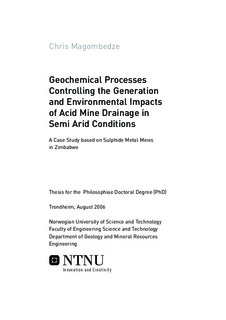| dc.description.abstract | This study evaluates the geochemical processes that control the geochemistry of acid mine drainage in semi arid conditions. The central objective is to characterise and understand the evolution of acid mine drainage and its potential environmental impacts on the Mazowe River sub-catchment, in north east Zimbabwe. The work is based on a case study at three neighbouring metal sulphide mines, namely Trojan Nickel Mine, Mazowe Gold Mine and Iron Duke Pyrites.
The methodology used in this research includes site assessment and characterisation of tailings dumps; waste rock samples; drainage from dumps; surface water and groundwater in the vicinity of the selected mine sites. Geochemical modelling with Phreeqc was used to evaluate pollutant attenuation mechanisms and thereby interpret the environmental effects of over 6 years of acidic seepage infiltration into the groundwater at the most acidic mine in the country, Iron Duke Pyrites. It was also used to predict the seasonal variation in drainage chemistry along Yellow Jacket and Mazowe Rivers due to mixing with other waters or drainage and reaction with bedrock downstream.
The study shows that during the wet season surface water is more prone to acidification than groundwater because the residence time of acidic drainage passing through the soil and shallow bedrock into streams is generally much shorter than that of drainage percolating through the unsaturated zone into the deeper groundwater flowpaths associated with the semi arid climate. During the hot dry season, water flow conditions are greatly reduced and may even stop. This is a favourable condition which limits the rates of sulphide oxidation, acid release and pollutant loadings to the environment. The study discusses several complex mechanisms which act simultaneously on the drainage as it migrates from the source minerals into water and soil changing its chemistry, viz: dilution, precipitation, hydrolysis, adsorption, desorption, complexation, cation exchange, diffusion and evaporation to dryness. These processes play an essential role in the natural attenuation and lowering of toxic concentrations of potentially harmful heavy metals in polluted water draining from the mine sites.
The study has also shown that prediction tests using the standard Sobek humidity cell procedure can overestimate the rates of sulphate generation for semi arid conditions by a factor of four, predicts a shorter time to acidity, and also estimates rather high chemical loadings to the environment than those actually measured when simulated rainfall conditions at a site are used.
Phreeqc geochemical modelling predicts that the resultant environmental effects of more than 6 years of acidic seepage infiltration into Yellow Jacket River at Iron Duke is "a pollution time bomb". A sulphate saturation front of 1795.2 mg/l is progressing through the subsurface at an estimated rate of 6.67 m per year towards the banks of the river. Considering that most of the metal pollutants are associated with sulphate as the dominant anion, a major pollution breakthrough is predicted to occur within 7.5 years when the sulphate saturation front reaches the river. However, simulation prediction shows that the situation could be abated by injecting unpolluted streamwater into the presently polluted aquifer, and shift equilibrium in favour of desorption of pollutants from the currently saturated cation exchangers to the water phase. This is expected to freshen sorption sites of the soil matrix, while allowing a slow dilution process from the injected water to clean up the polluted aquifer. | nb_NO |
